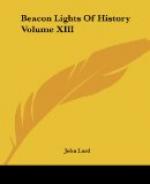It was during one of his rambles with his friend Ferguson to the English Lakes in 1797 that Scott met Miss Charlotte Margaret Carpenter, or Charpentier, a young French lady of notable beauty and lovely character. She had an income of about L200 a year, which, added to his earnings as an advocate, then about L150, encouraged him to offer to her his hand. For a young couple just starting in life L350 was an independence. The engagement met with no opposition from the lady’s family; and in December of 1797 Scott was married, and took a modest house in Castle Street, being then twenty-six years of age. The marriage turned out to be a happy one, although convenance had something to do with it.
Of course, so healthy and romantic a nature as Scott’s had not passed through the susceptible time of youth without a love affair. From so small a circumstance as the lending of his umbrella to a young lady (Margaret, the beautiful daughter of Sir John Belches) he enjoyed five years of affection and of what seems to have been a reasonable hope, which, however, was finally ended by the young lady’s marrying Mr. William Forbes, a well-to-do banker, and later one of Scott’s best friends. “Three years of dreaming and two years of waking,” Scott calls it in one of his diaries, thirty years later; and his own marriage followed within a year after that of his lost love.
With an income sufficient only for the necessities of life, as a married man in society Scott had not much to spare for expensive dinners, although given to hospitality. What money he could save was spent for books and travel. At twenty-six, he had visited what was most interesting in Scotland, either in scenery or historical associations, and some parts of England, especially the Cumberland Lakes. He took a cottage at Lasswade, near Edinburgh, and began there the fascinating pursuit of tree-planting and “place"-making. His vacations when the Courts were not in session were spent in excursions to mountain scenery and those retired villages where he could pick up antiquarian lore, particularly old Border ballads, heroic traditions of the times of chivalry, and of the conflicts of Scottish chieftains. Concerning these no man in Scotland knew so much as he, his knowledge furnishing the foundation alike of his lays and his romances. His enthusiasm for these scenic and historic interests was unquenchable,—a source of perpetual enjoyment, which made him a most acceptable visitor wherever he chose to go, both among antiquaries and literary men, and ladies of rank and fashion.
In March, 1799, Mr. and Mrs. Scott visited London, where they were introduced to many distinguished literary men. On their return to Edinburgh, the office of sheriff depute of Selkirkshire having become vacant, worth L300 a year, Scott received the appointment, which increased his income to about L700. Although his labors were light, the office entailed the necessity of living in that county a few months in each year. It was a pastoral, quiet, peaceful part of the country, belonging to the Duke of Buccleuch, his friend and patron. His published translation in this year of Goethe’s “Goetz of Berlichingen” added to his growing reputation, and led him on towards his career.




